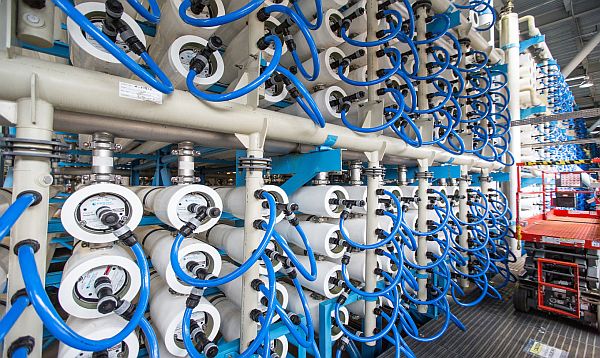San Diego, California - The United States imports vehicles, equipment, fresh produce and other goods from Mexico. That list may soon include water too, now that a San Diego County water district is looking south for help to diversify its supply.
The Otay Water District serves a population of 220,000 people in southeastern San Diego County, in a service area spanning 125 square miles, from the border city of Chula Vista to the unincorporated areas in Jamul. It currently buys potable water from the Metropolitan Water District of Southern California, the San Diego County Water Authority and the Helix Water District.
But it's also seeking more control over its supply, so it has taken the unusual step of seeking to import water from Mexico - the first such venture by the United States.
A consortium of international companies plans to build the largest desalination plant in the West in Rosarito, Mexico, a coastal resort city in Baja California, about 15 miles south of the U.S. border. Otay Water District is interested in buying some of that water and piping it up north.
Plans for the plant were mired in legal squabbles for a while, but things moved forward in 2016, and if the consortium gets its financing in line, it will break ground in May. The first phase, with 50 million gallons of water in daily capacity, will be completed in 2019 or 2020.
 |
Cost of imported water
Piping water from Mexico would mean Otay Water District is relying on an imported resource, so how does it expect to have more control over its supply?
Mark Watton, general manager of Otay Water District, explains that it would be a closer source and a steady supply, unlike sources that come through the Sacramento-San Joaquin Bay-Delta, which make up part of the supply for wholesale distributors such as the Metropolitan Water District.
The amount of water that SDCWA gets from the Delta also varies from year to year. In addition, SDCWA gets water from the Colorado River, for which it has high priority through a transfer agreement with the Imperial Irrigation District, but Watton says the Rosarito plant would offer the Otay Water District better control over supply.
However, it will not offer major financial savings. "We are looking to replace our current water sources at the same or better price. Right now I pay the Water Authority about $1,700 per acre-foot [325,851 gallons] and the goal for us is to get the supply from desal [desalination] at the same cost," he said. "It's a little tight, but we still think it's feasible."
Environmental concerns
There are concerns that water piped from south of the border may not be subject to the stringent requirements of the California Environmental Quality Act. But Watton brushes aside environmental concerns about water quality, insisting that Mexico has the equivalent of the US Environmental Protection Agency and that projects down south get similar reviews and public hearings.
"The difference is they don't have the environment for lots of lawsuits that can tie up projects for years," Watton said, referring to the Carlsbad desalination plant in northern San Diego County that took more than a decade to build and faced lawsuits over environmental issues.
However, California has stricter regulations than other parts of the country when it comes to desalination, now requiring the use of subsurface intake pipes for most projects, which is just one of the issues holding up permission for a Huntington Beach plant, which has been seeking approval for 15 years.
 |
The San Antonio de los Buenos sewage plant at Punta Bandera is located 7 miles south of the U.S. border and discharges 13-27 million gallons a day (or more, depending on the weather conditions) of untreated and partially treated sewage water into the Pacific Ocean. The Scripps Institution of Oceanography is studying how long it takes plumes of pollution to reach Imperial Beach, which suffers frequent closures. Another prime source of pollution is from the Tijuana River, which empties into the Pacific Ocean near Imperial Beach.
U.S. and Mexican stakeholders agree that pollution cleanup in the border area needs to happen, but funding issues have stalled the efforts.
"We've been very clear to authorities that if they're going to fast-track the desal plant, they need to fast-track the sewage cleanup," Dedina says. The desalination plant is about 10 miles south of the sewage plant. "There should be no U.S. investment or approval for a pipeline across the border until that water is cleaned up. I don't think U.S. consumers would be interested in buying this water if they knew of these conditions."
Otay Water District's Watton agrees with Dedina's concerns about the sewage issue hurting Imperial Beach, but doesn't believe it's an issue for the desalination plant.
"Yes, Serge is right: The discharge is a problem and they do post 'No Swimming' signs on the beach," Watton says. "But what he is trying to do is leverage the desal plant to force the Mexican government to clean up the sewage."
In any case, Watton points out, the decision to go ahead with the desalination plant has already been made. He insists that the plant is not close to the sewage facility and will not use sewage water. "The sewage discharge needs to be addressed, but it's completely divorced from the desalination plant."
Padma Nagappan is a San Diego-based health and environment reporter. This article originally appeared on Water Deeply, and you can find the original HERE.


